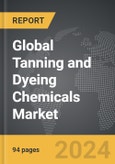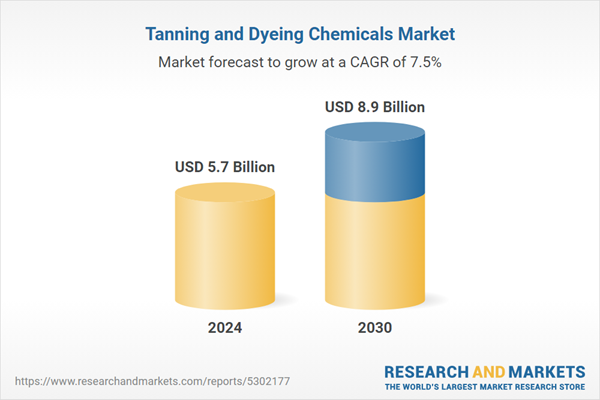Global Tanning and Dyeing Chemicals Market - Key Trends and Drivers Summarized
What Makes Tanning and Dyeing Chemicals Essential in Various Industries?
Tanning and dyeing chemicals are vital components in the processing of textiles, leather, and a wide range of other materials, serving a fundamental role in imparting desirable aesthetic and functional properties. These chemicals facilitate the transformation of raw materials into finished goods with enhanced color, texture, durability, and resistance to environmental factors. Tanning chemicals, for instance, are crucial in converting raw animal hides into durable and usable leather. Through a series of chemical processes - commonly including the use of chromium, vegetable tannins, and aldehyde-based agents - the leather is stabilized, gaining strength, flexibility, and longevity, which is essential for its use in footwear, fashion, upholstery, and automotive interiors. Dyeing chemicals, on the other hand, are used to impart vibrant and stable colors to textiles, yarns, and fabrics, making them suitable for various applications ranging from apparel and home textiles to industrial fabrics and technical textiles. The effectiveness of dyeing chemicals depends on factors such as dye compatibility, fabric type, and dye-fixation methods, making it a highly specialized field within chemical engineering. Moreover, the recent surge in demand for high-performance fabrics, including water-repellent, flame-resistant, and UV-protective textiles, has led to an increase in the use of advanced dyeing and finishing chemicals that confer additional functionalities to the fabrics.How Are Innovations in Tanning and Dyeing Chemicals Transforming the Industry?
Innovations in tanning and dyeing chemicals are transforming the industry by addressing environmental concerns and improving the quality and efficiency of material processing. Traditionally, tanning and dyeing have been associated with significant environmental impact due to the use of heavy metals, synthetic dyes, and large amounts of water and energy. However, advancements in chemical formulations and processing technologies are now paving the way for more sustainable practices. For instance, in the leather industry, the shift towards using eco-friendly tanning agents like plant-based tannins, syntans, and biodegradable polymers has significantly reduced the reliance on chromium salts, which are known to cause environmental and health issues. Similarly, alternative tanning methods such as enzymatic tanning and organic acid-based tanning are gaining traction as they offer a lower environmental footprint while maintaining high leather quality. In the dyeing sector, innovations like low-water dyeing technologies, digital printing, and the use of bio-based dyes have gained prominence. Low-impact dyes and digital dyeing systems minimize water and chemical use, reduce effluent generation, and allow for greater design flexibility, thus enhancing sustainability. Furthermore, chemical companies are developing smart dyes and coatings that respond to external stimuli like temperature, pH, or light, enabling the production of materials with dynamic color-changing or self-cleaning properties. The integration of nanotechnology and advanced dye-fixing agents has also led to improved dye uptake, color fastness, and reduced fading, which are essential for meeting the high-performance standards of the fashion and technical textile industries.What Challenges Are Shaping the Tanning and Dyeing Chemicals Market?
The tanning and dyeing chemicals market is shaped by a variety of challenges, spanning environmental, regulatory, and economic aspects. One of the primary issues is the environmental impact of conventional tanning and dyeing processes, which often involve toxic chemicals, heavy metals, and large volumes of water. Textile dyeing is known to be a major contributor to water pollution, with untreated dye effluents contaminating waterways and disrupting ecosystems. As a result, manufacturers are under increasing pressure to adopt more sustainable and eco-friendly chemicals and processes. Another challenge is the high cost and limited availability of sustainable alternatives. While eco-friendly tanning agents and natural dyes offer lower environmental impact, they often come at a premium cost and may require new infrastructure or modifications in the production process, posing financial challenges for smaller manufacturers. Technical challenges also arise in ensuring that sustainable chemicals can match the performance, durability, and aesthetic qualities of their traditional counterparts. Ensuring consistency and quality in large-scale applications remains a concern, especially when dealing with natural or bio-based dyes, which can vary in color strength and stability. Another critical issue is the complex regulatory landscape, which varies significantly across different regions and often lacks harmonization. Addressing these challenges requires a multi-faceted approach that combines innovation, investment in new technologies, and collaborative efforts across the supply chain to create a more sustainable and economically viable tanning and dyeing industry.What Factors Are Driving Growth in the Tanning and Dyeing Chemicals Market?
The growth in the tanning and dyeing chemicals market is driven by several factors, including rising demand for high-quality finished products, advancements in chemical formulations, and the push towards more sustainable and efficient production practices. One of the key drivers is the increasing consumer preference for premium leather goods and textiles, which require sophisticated tanning and dyeing processes to achieve superior aesthetic and functional properties. This trend is particularly prominent in the fashion, automotive, and home décor sectors, where product differentiation through color quality, texture, and durability is crucial. Additionally, the growing emphasis on sustainability in the textile and leather industries is propelling the adoption of eco-friendly chemicals that minimize environmental impact. Regulatory pressures and consumer awareness regarding the environmental footprint of traditional chemicals have encouraged manufacturers to invest in green chemistry innovations, such as plant-based dyes, non-toxic tanning agents, and waterless dyeing technologies. Another significant factor driving growth is the expansion of technical textiles, which are used in various sectors including healthcare, construction, and sports. These applications demand high-performance materials with enhanced properties like UV resistance, antimicrobial activity, and water repellency, which are achieved through advanced dyeing and finishing chemicals. Moreover, technological advancements in dye synthesis and application methods, such as digital dyeing and automation in textile processing, are boosting the efficiency and precision of dyeing operations, reducing waste, and enabling customization on a large scale. The rise of smart textiles - fabrics that incorporate electronic components or change color in response to stimuli - has also spurred demand for specialized dyes and coatings, further expanding the market. Lastly, the shift towards on-demand and short production runs in the textile industry, driven by fast fashion and the need for rapid prototyping, is creating new opportunities for innovative dyeing and finishing solutions that can offer quick turnaround times and reduced inventory costs. These factors collectively contribute to the robust growth of the tanning and dyeing chemicals market, setting the stage for continued innovation and expansion in the coming years.Report Scope
The report analyzes the Tanning and Dyeing Chemicals market, presented in terms of market value (US$ Thousand). The analysis covers the key segments and geographic regions outlined below.- Segments: End-Use (Footwear, Upholstery, Garments, Leather Goods).
- Geographic Regions/Countries:World; United States; Canada; Japan; China; Europe (France; Germany; Italy; United Kingdom; Spain; Russia; and Rest of Europe); Asia-Pacific (Australia; India; South Korea; and Rest of Asia-Pacific); Latin America (Argentina; Brazil; Mexico; and Rest of Latin America); Middle East (Iran; Israel; Saudi Arabia; United Arab Emirates; and Rest of Middle East); and Africa.
Key Insights:
- Market Growth: Understand the significant growth trajectory of the Footwear End-Use segment, which is expected to reach US$3.9 Billion by 2030 with a CAGR of a 7.4%. The Upholstery End-Use segment is also set to grow at 7.9% CAGR over the analysis period.
- Regional Analysis: Gain insights into the U.S. market, valued at $1.5 Billion in 2024, and China, forecasted to grow at an impressive 10.8% CAGR to reach $2.1 Billion by 2030. Discover growth trends in other key regions, including Japan, Canada, Germany, and the Asia-Pacific.
Why You Should Buy This Report:
- Detailed Market Analysis: Access a thorough analysis of the Global Tanning and Dyeing Chemicals Market, covering all major geographic regions and market segments.
- Competitive Insights: Get an overview of the competitive landscape, including the market presence of major players across different geographies.
- Future Trends and Drivers: Understand the key trends and drivers shaping the future of the Global Tanning and Dyeing Chemicals Market.
- Actionable Insights: Benefit from actionable insights that can help you identify new revenue opportunities and make strategic business decisions.
Key Questions Answered:
- How is the Global Tanning and Dyeing Chemicals Market expected to evolve by 2030?
- What are the main drivers and restraints affecting the market?
- Which market segments will grow the most over the forecast period?
- How will market shares for different regions and segments change by 2030?
- Who are the leading players in the market, and what are their prospects?
Report Features:
- Comprehensive Market Data: Independent analysis of annual sales and market forecasts in US$ Million from 2024 to 2030.
- In-Depth Regional Analysis: Detailed insights into key markets, including the U.S., China, Japan, Canada, Europe, Asia-Pacific, Latin America, Middle East, and Africa.
- Company Profiles: Coverage of players such as BASF SE, Bayer AG, Chemtan Company, Clariant International Ltd., DyStar Singapore Pte Ltd. and more.
- Complimentary Updates: Receive free report updates for one year to keep you informed of the latest market developments.
Some of the 43 companies featured in this Tanning and Dyeing Chemicals market report include:
- BASF SE
- Bayer AG
- Chemtan Company
- Clariant International Ltd.
- DyStar Singapore Pte Ltd.
- Elementis plc
- Lanxess AG
- Schill & Seilacher Gmbh & Co. KG
- Stahl International BV
- TFL Ledertechnik Gmbh & Co. KG
This edition integrates the latest global trade and economic shifts into comprehensive market analysis. Key updates include:
- Tariff and Trade Impact: Insights into global tariff negotiations across 180+ countries, with analysis of supply chain turbulence, sourcing disruptions, and geographic realignment. Special focus on 2025 as a pivotal year for trade tensions, including updated perspectives on the Trump-era tariffs.
- Adjusted Forecasts and Analytics: Revised global and regional market forecasts through 2030, incorporating tariff effects, economic uncertainty, and structural changes in globalization. Includes historical analysis from 2015 to 2023.
- Strategic Market Dynamics: Evaluation of revised market prospects, regional outlooks, and key economic indicators such as population and urbanization trends.
- Innovation & Technology Trends: Latest developments in product and process innovation, emerging technologies, and key industry drivers shaping the competitive landscape.
- Competitive Intelligence: Updated global market share estimates for 2025, competitive positioning of major players (Strong/Active/Niche/Trivial), and refined focus on leading global brands and core players.
- Expert Insight & Commentary: Strategic analysis from economists, trade experts, and domain specialists to contextualize market shifts and identify emerging opportunities.
Table of Contents
Companies Mentioned (Partial List)
A selection of companies mentioned in this report includes, but is not limited to:
- BASF SE
- Bayer AG
- Chemtan Company
- Clariant International Ltd.
- DyStar Singapore Pte Ltd.
- Elementis plc
- Lanxess AG
- Schill & Seilacher Gmbh & Co. KG
- Stahl International BV
- TFL Ledertechnik Gmbh & Co. KG
Table Information
| Report Attribute | Details |
|---|---|
| No. of Pages | 187 |
| Published | December 2025 |
| Forecast Period | 2024 - 2030 |
| Estimated Market Value ( USD | $ 5.7 Billion |
| Forecasted Market Value ( USD | $ 8.9 Billion |
| Compound Annual Growth Rate | 7.5% |
| Regions Covered | Global |









